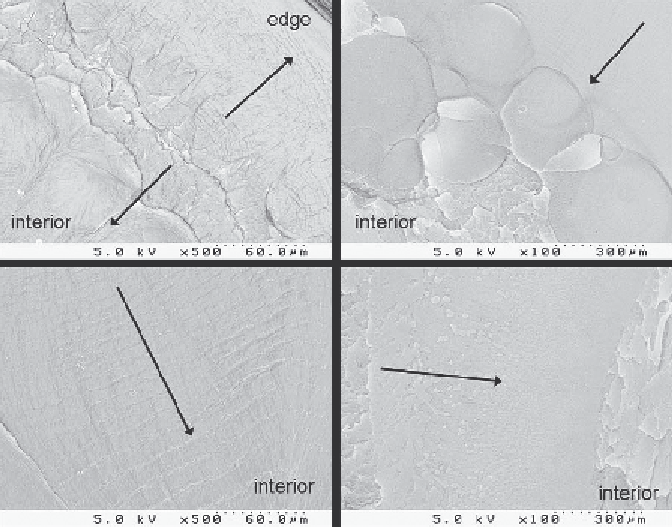Biomedical Engineering Reference
In-Depth Information
Figure 5.17
Magnified views of
the key features of the surfaces
in
Fig. 5.16
: (a) Initiation ridge,
(b) parabolic markings, (c) fatigue
striations, and (d) patch
morphology indicative of crazing.
Arrows indicate direction of
crack growth. Courtesy of Ref.
[39]
.
(a)
(b)
(c)
(d)
geometry) factors, affect the fracture and fatigue
properties of PEEK. Fracture in low-molecular-
weight PEEK (150G) is an intraspherulitic process,
whereas fracture in high-molecular-weight PEEK
(450G) is an interspherulitic process. Under
monotonic loading conditions and in the presence
of a notch, PEEK is a notch-weakening material in
which notching suppresses gross deformation of the
specimen and, as a consequence, alters the micro-
mechanism of fracture. Under
S
e
N
type cyclic
loading, the majority of the lifetime for PEEK is
spent in initiation of the critical flaw/crack, and
increasing notch severity decreases fatigue lifetime.
In summary, the fracture behavior of neat PEEK
under monotonic and cyclic loading conditions and
in the presence of stress concentrations, such as could
be a design element of an orthopedic component, was
considered in this chapter. There is still much work to
be done on the fracture and fatigue behavior of PEEK
blends and composites, such as carbon fiber- or glass
fiber-reinforced PEEK. This work is warranted, as
these new formulations become candidates for use in
orthopedic implant applications.
GM07250, Invibio, Inc., the CWRU Department of
Orthopaedics Allen Fellowship, and the Wilbert
J. Austin Professor of Engineering Chair.
References
[1] D.J. Astion, P. Saluan, B.N. Stulberg,
C.M. Rimnac, S. Li, The porous-coated
anatomic total hip prosthesis: failure of the
metal-backed acetabular component, J. Bone Jt.
Surg. Am. 78 (1996) 755
e
766.
[2] M. Birman, P. Noble, M. Conditt, S. Li,
K. Mathis, Cracking and impingement in ultra-
high-molecular-weight polyethylene acetabular
liners, J. Arthroplasty 20 (2005) 87
e
92.
[3] J.P. Collier, M.B. Mayor, R.E. Jensen,
V.A. Surprenant, H.P. Surprenant, J.L. McNamar,
et al., Mechanisms of failure of modular pros-
theses, Clin. Orthop. 285 (1992) 129
e
139.
[4] D.J. Berry, C.L. Barnes, R.D. Scott,
M.E. Cabanela, R. Poss, Catastrophic failure of
the polyethylene liner of uncemented acetabular
components, J. Bone Jt. Surg. Br. 76 (1994)
575
e
578.
[5] Y. Chiu, W. Chen, C. Huang, C. Chiang,
T.H. Chen, Fracture of the polyethylene tibial post
in a NexGen posterior-stabilized knee prosthesis,
J. Arthroplasty 19 (2004) 1045
e
1049.
Acknowledgments
The reported research of the authors was sup-
ported in part by NIH (NIAMS) R01 AR47192, T32

